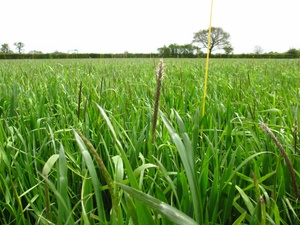During the 1960s there were many films on the telly and at the cinema that were set in California. Looking back they were pretty awful. On the other hand, they were great advertisements for the Californian way of life. One thing that really impressed me in those days was that all their residential garage doors seemed to automatically open. Not to be outdone, we had an automatic opening door fitted to our garage around three years ago.
The big problem is that there is so much rubbish in our garage that we do not have room for one car let alone the two it was designed to accommodate. Matters came to a head a couple of weeks ago when we had a delivery from a builder’s merchant. They were items for some internal changes to our house and had to be stored in the dry. Space had to be made available in the garage and I was sent out to create it.
It was then that I came across a very short Weed Research Organisation report on the role of post-harvest cultivations to encourage the establishment of black-grass seedlings. There is a detailed paper on these trials written by Stephen Moss and presented to the BCPC Congress in 1978.

The cultivations were done in early August and the counts were made in mid-October. The general conclusion was that not doing any cultivation at all was equal or better than shallow cultivations in encouraging black-grass seedlings to establish by mid-October.
The trials were done in the autumns of 1975 and 1976 and the counts show that in some cases thousands of seedlings were established per square metre. It is amazing what black-grass populations could be tolerated in those days when chlorotoluron or isoproturon were providing from a single application 99% control of heads on average in winter wheat or winter barley.
The straw on the plots was removed at harvest and the remaining stubble was not burnt. The prevailing weather was extremely dry, with some rain in late September. At the time these trials were an eye opener for me and ever since I have always encouraged no cultivation at all to be a treatment in stubble management trials. This advice was nearly always ignored!
Before I go any further, I have to emphasise that the number of black-grass seedlings encouraged to establish before drilling may not be a reliable guide to the total loss of viable seed. A truer guide is the number of black-grass seedlings emerging in the immediately following autumn-sown crop.
A few decades after the original work by Stephen Moss, the significance of between-crop management of black-grass has increased, not only because of the development of black-grass resistance to herbicides but also because of the more widespread adoption of shallow tillage. Shallow tillage results in a lower proportion of the black-grass seed buried to below 4-5 cm, the depth below which it will not emerge.
Data recently generated in Northern Europe and also in NIAB TAG trials show that not cultivating stubbles at all can reduce the number of black-grass seedlings, when compared to shallow cultivation(s), in a crop sown later in the same autumn. This is providing that the soil and weather conditions are pretty dry between black-grass seed shed and the drilling date of the subsequent autumn-sown crop. On the other hand, the opposite is true when conditions are moist where stubble cultivations seem to reduce black-grass emergence in a crop sown in the same autumn.
Despite its importance, the advice on stubble cultivation for black-grass control between successive autumn-sown crops has been all over the place in recent years. The extreme recommendations have been not to cultivate at all and the employment of a super heavy roller to really consolidate cultivated ground and produce a tight and fine surface layer of soil.
This variation in advice means that it is worth getting back to basics in order to clarify the situation. The key to optimising the value of stubble management is an understanding of the conditions needed to maximise black-grass germination.
There are three requirements for black-grass germination in the late summer and early autumn: the black-grass seed has to imbibe sufficient water for germination, it has to be exposed to light and it has to be non-dormant. Also, please remember that it needs to be in the top 4-5 cm of soil for it to emerge. This all seems straightforward but there are misleading statements that can lead us astray. These seem to centre on the need for light to enable emergence.
There is no need for the seed to be exposed to light for long periods. Provided that the seed is non-dormant and imbibed, the need for light is minimal. A 1970s scientific paper even suggested that it needed to be only a flash of light. This seems to ring true given the current enthusiasm for not disturbing seedbeds too much in the spring to avoid black-grass emergence. Certainly, a paper published 10 or so years ago suggested that less than five seconds of exposure to light was required. In addition, the light need not be direct sunlight. Pre-harvest, black-grass seed on the soil surface at the bottom of a cereal canopy will get sufficient light for germination as well as seed close to the surface of a relatively coarse seedbed. Hence, no super heavy rollers shutting out the light please!

And so, on the basis that prolonged exposure to light is not important, the focus has to move to what is the best situation for freshly shed seed to become imbibed in a dry autumn. It may well be on the soil surface rather than after a cultivation that results in an extremely dry seedbed. Embedded in the soil surface amongst the trash from the crop (chaff and chopped straw) may provide a moister environment for the seed because of dews and any light showers.
I could get more techie on this issue and perhaps I am in danger of over-simplifying because there is a myriad of individual circumstances. For instance, where there is no freshly shed seed, all the viable black-grass seed will be in the soil and so cultivation is needed, even in dry conditions, to expose them to light. In this circumstance it is best to produce the final(ish) seedbed as soon as possible in order that the black-grass seed likely to produce plants after drilling (i.e. those in the top 4-5cm of soil at drilling) is given the opportunity to germinate and emerge before drilling.
More consideration is required where freshly shed seed is the main target. In very dry conditions, delaying shallow cultivations until there is more moisture around may be optimal. Re-cultivating may be needed to expose seed that was dormant when the previous shallow cultivation(s) was carried out, should that cultivation have created a very fine seedbed and blocked out the light.
So it all becomes a rather complicated judgement on not only the best way to encourage freshly shed seed to germinate but also to take into account the relative numbers of seeds shed in previous years that are likely to be in the top 5 cm of the final seedbed for the immediately following autumn-sown crop.
I know that I have given the same views in a very recent blog but I thought it worthwhile repeating the message with an explanation as to why the approach to ‘stale seedbeds’ should vary according to black-grass seed depth at harvest and to weather conditions. In addition, I accept that there is more to life that optimising the reduction in viable black-grass seeds between crops.
Volunteer cereals and sterile brome need to be buried under a shallow layer of soil to optimise germination. Also, many farmers on heavy soils cultivate to 15-20 cm depth and press the soil immediately after harvest in order that the soil surface layers have time to ‘weather’ and do much of the seedbed preparation. Trials show that in moist conditions this approach results in less black-grass in the immediately following autumn-sown crop when compared to leaving the soil undisturbed until just before drilling.
